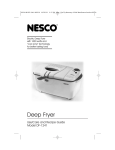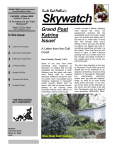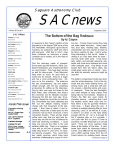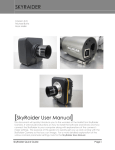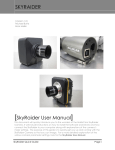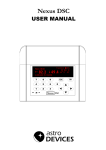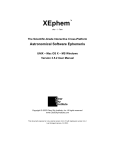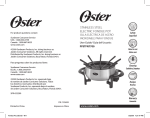Download Fall 2006 - Uncle Rod`s Astroland
Transcript
Uncle Rod Mollise’s Down Home Gumbo Astronomy From Chaos Manor South ! Skywatch Fall 2006 Volume 15, Issue 3 “A Newsletter for the Truly Outbound!” Number 82 (New Series) <[email protected]> In this Issue: 1 Second Look at AstroPlanner 2 A Chiefland Virgin 3 Building an Eagle’s Nest 4 MTF and Chocolate 5 Indoor Collimation 6 Review: Pocket Sky Atlas 7 ETX-125 Focus Aid 8 Astro Video Supplement! 9 My Back Pages! : Sometimes It Pays to Take a Second Look Uncle Rod Skywatch 1207 Selma Street Mobile, AL 36604 U.S.A. H ave y’all seen my laptop lately? If you’ve had a peek over my shoulder from the seat next to me on an airplane (I saw you, you li’l dickens), you’re probably thinkin’, “Gull-dernit, that silly old Uncle Rod has more astronomy software than humans should be allowed to have.” Which is mostly true, I guess. In my role as astronomy pundit, I get asked to take a look at a lot of stuff; everything from the latest TheSky to little utilities designed to help you polar align that bad, ol’ GEM. I don’t mind saying that I’ve got all the biggies living on my sorely laden hard drive. What you’re probably wondering, though, is, “How much of that stuff does he actually use?” Not much, I’ll admit. Excluding imaging software, I find myself really using, day-to-day using, two packages. One of these is a planetarium, something that will give me immediate visual feedback about the way the sky looks right now or will look tonight or next week. Click an icon, the sky appears on my screen, and I can decide if Orion’s up yet without puttin’ my thinkin’ cap on. I said “two packages.” Yep. The other type of program I use is a “planner.” You know, one of those mega-database jobs that help you plan observing sessions, draw finder charts, send a scope on gotos, check the weather, and make your lunch. I’m kidding about the lunch, but planners have come a long way since the days when they were thinly disguised Access databases and nothing more. I’ve found these programs really enhance my observing productivity. Let’s face it, without lists of objects to look at you’re going to be lost among the stars, real or virtual. Just because a program draws a pretty sky on your screen doesn’t mean you’ll know which objects in that pretty sky you’ll want to observe. Planners help you decide which objects you want to see, and furnish you with sorted lists of these objects visible at the time of your viewing session. I’d been using two planners almost interchangeably for several years, Steve Tuma’s Deepsky and Greg Crinklaw’s Skytools 2, both fine programs I’d recommend to anybody. These apps are good enough, in fact, that I didn’t think there was room for a third entry, and was surprised when I got an email from a nice gentleman named Paul Rodman, asking if I’d take a . . . . . . . . . . . . . . . . . . . . . . . look at AstroPlanner. his planner, In due course, I received an AstroPlanner (AP) CD from Paul (Ilanga Software) and had it installed on my then current 566mhz Win98 machine. What did I think? Well, to be kind, AstroPlanner seemed a work in progress. The program was, for example, without an installation routine of any kind, so I had to do most of the work myself when it came to getting the thing set up on a hard drive, copying files and making directories. Copying files may seem like a simple task to y’all, but, believe me, it’s something that can be a challenge for the resolutely computer illiterate—like your Silly Old Uncle. Once installed AP was, well, interesting. The user interface was nicely designed—the various program modules resided on well thought-out tabs, and there were some nice touches, especially for Meade owners, like an update of Jim Burrows' famous BestPair program to help Autostar users select good alignment stars. Alas, the bad tended to outweigh the good. Paul’s initial reason for doing AstroPlanner was to provide Apple Macintosh users with a planning program of their own, and the Apple version was nice, but the Windows version seemed an afterthought, being affected by a serious limitation. Due to a “resources” issue, AP would not run very well at all under Windows 98, which dampened my enthusiasm. Hell, just trying to print would often bring a crash. It became obvious the program needed Windows 2 2000 or NT, and it was at that point that I lost interest. Me upgrade to another Windows yet again? Uh-uh! - And yet…and yet… One thing I noticed right off the bat was that Paul had accumulated a Yahoogroup full of enthusiastic users in a short period of time. They saw plenty of potential in the program, and, actually, I guess I did too. It had a certain something, some ineffable look and feel that I found attractive. If only it had worked a little better on my computer. I soldiered on with Deepsky and Skytools. Mr. Rodman’s little program stuck in my mind, though, and when I next heard from him a couple of years down the line, I had not forgotten AstroPlanner. - - - What was new with AP? Apparently it had come a long way. Paul rattled off a long, long list of features, and promised me the program would work very well on my new XP laptop. He wondered if I might take a second look. Heck, what’s one more astro-app, bursting hard drive or no? I said “yes,” both out of curiosity to see if this promising program had really gotten off the ground, and because I was attracted by a list of features than included online download and caching of DSS images, telescope control for just about anything, and impressively large catalog resources (over 100 catalogs; everything from the good, old NGC to stuff like the Galactic Dust Cloud catalog). A very partial list of AstroPlanner’s features includes: - Cross-platform operation. AstroPlanner is available for both Windows PCs and the Apple Macintosh “classic” and OSX machines. Reads geographic coordinates from a GPS unit, a Meade Telescope, or from Google Earth. Choose your equipment lineup from an extensive list of telescopes and binoculars or setup your particular equipment manually. Create Observing plans/lists to suit you, your site, and your equipment. Field of view charting with many options and capabilities. Extensive support for goto telescopes. Incorporates Best Pair II to assist in goto telescope alignment star selection. All-sky charts available with a mouse click. User-defined data fields can be added to plans. Extensive catalog search facilities. Over 100 catalogs containing over 1,000,000 objects. UCAC and USNO A2.0 catalogs (optional). USNO B1.0 on-line access. Flexible search capabilities. An extensive library of user-contributed plans is available online through the program interface. This includes lists containing all the objects in Burnham’s Celestial . . . . . . . . . . . . . . . . . . . . . . . . Skywatch in two places. The first place is “Resources,” found under the Edit menu (folks, I’m talking only about the Windows version in this review). Here’s where you tell the program where you’re located, what kind of telescope you use, and which eyepieces and accessories you own. It’s remarkably easy to get all this data entered—as long as you remember the central AstroPlanner interface paradigm: click a “+” button onscreen to add something; click an found that for a site’s time to show up correctly in the program, I had to set the “time offset” to the value by which the site’s time would be different from the computer’s time. Since my computer is “on” Central Time, I had to set the offset selection to “1” for a site on Eastern Time. I’d a-thought setting the site’s time zone (in the “offset from GMT” field) would have done that, but no-sir buddy. To say the least, I was convinced the program deserved another look, and, when I received the new CD, I set about getting it up and running on my PC. The Good Thing here is that the installation process for the program has long-since been automated. Put the CD in the drive, and away you go. I didn’t try a Mac installation, but I’m told the process is just as easy there. Something to think about before you go installing this program on your PC, though, is that while much has been updated, one thing that has not changed is the way AP works (or doesn’t) under Windows 98. Yes, most folks have probably long-since upgraded to XP, but some of us still tend to use older machines as observatory computers. If you want to use AP, you need Win2000/NT or XP (or a Mac). Period. onscreen “-“ to delete something. Remember that and, you’ll do OK. Don’t go typing and clicking randomly and aimlessly as your Old Uncle is wont to do. Without first telling the program to add a new site with “+,” you won’t get anywhere other than Frustrationsville. With the installation complete, as with any astronomy program, you are only halfway there. Before using AstroPlanner, you must input your equipment and information about your geographic location. You do this Most of the site setup “questions” are self-explanatory, and include the usual items like latitude and longitude, DST status, and other site peculiar information and choices. One slight hang-up I had was that I Maybe now is a good time to talk about the AP help system. It doesn’t have one per se. You do have an online (and on hard drive) manual that’s pretty good, but it’s still not as detailed, even at over 300 .pdf pages, as it could be for such a complex and capable application. I read the information in this manual concerning clock offset, for example, and still came away scratching my head. I just played around until the time on the program display was correct for the site. - - - Handbook and the Night Sky Observer’s Guide. AAVSO finder and constellation charts, observation data, and observation planner. Solar system objects including minor planets & asteroids can be plotted on charts and added to plans. Import facilities for data on comets and minor planets. PDA support for Astromist, Planetarium for Palm, and PalmDSC. . . . . . . . . . . . . . . . . . . . . . . . . 3 Once you’ve got your location or locations registered, it’s time to tell AP the specific scopes and eyepieces you’ve got in your equipment inventory. It will use this data for computing field sizes in its charting module, in assisting you in filling-in your log entries, and in determining object visibility for a particular scope/eyepiece combo. I found it significantly easier to set up eyepieces and scopes with AP than with TheSky 6. In part, this was because of the long and constantly updated lists of scopes and oculars in AstroPlanner. The program has the most extensive list of eyepieces I’ve seen. I was amazed, for example, to find my beloved WO Uwans—not yet a household word—there. In addition to scopes and eyepieces, you’ll also be allowed to tell AP about your inventory of filters—OIIIs, UHCs, etc. – and what AP calls “visual aids,” barlows and focal reducers. 4 When you’re done in Resources, “Preferences” is next on your agenda. This item is the last entry under the Edit menu. One thing Preferences does is allow you to set, well, your preferences as far as program appearance and function go. At this early stage of the game, you may want to just leave these settings at their defaults. You’ll need to use AP for a while before you start monkeying around with fine-tuning. Anyhoo, I think you’ll find the program looks and acts pretty “right” as shipped. One other thing you’ll find under a Preferences tab (AP’s Windows version is BIG on tabbed menus, which, in my opinion is a good thing), is a place to tell the identify your goto telescope. These days, most programs use the ASCOM application for goto scope interfacing, AP, however, has its own built-in drivers, so there are no additional “external” programs to load or mess with. The trade off, of course, is that when new scopes or features come out, you have to rely on Ilanga to update the drivers. ASCOM releases tend to come very quickly on the heels of new scope and new scope firmware introductions. While you won’t use an external program for scope interfacing, that doesn’t mean AP can’t interact with external programs. Via the “External” tab, you can, for example, tell AstroPlanner to work with Cartes du Ciel, the famous shareware planetarium program. With CdC enabled, clicking on AP’s Field of View tab will automatically bring up Cartes with its display centered on the same spot as AP’s Field of View. Using CdC with AP gives the program more robust charting capabilities than those contained in its own charting module (which we’ll discuss shortly). After you’ve finished with all this configuratin’, you can actually start using the program. You’ll do that by developing observing plans which are displayed on the program’s main screen, the one found under the “Observing” tab. How do you develop a plan? You may not have to. Plans, lists of objects, can be downloaded from the AP website via “UserContributed Plans” under the File menu (assuming you have an Internet connection). Once a downloaded plan is saved on your hard drive, it is opened with, surprise, “Open,” which is also found under the file menu. Let’s say none of the User Plans in the AP library suit your fancy, though. Maybe your idea of the “best” spring DSOs differs from that of Robert Burnham or Scotty Houston. If so, it’s very easy to put your own list together using . . . . . . . . . . . . . . . . . . . . . . . . Skywatch the search and selection tools found under AP’s “Planning” tab, the spot where you find and choose objects for inclusion in your list. Or, if, like me, you’re lazy, you can quickly develop a list by using the program’s Plan Creation Wizard. Choose this option from under the File menu and you’ll be presented with a dialog box that will allow you to set the criteria the program will use for plucking candidate objects from its enormous array of databases. You’re allowed to select constellations, catalogs, object difficulty (based on the aperture of the scope you have selected), object types, and numbers of objects per object type. Once the program has a list displayed, you can go through and select only the objects you like, or you can choose ‘em all. Selected objects will appear as a list in the Observing tab and will comprise an Observing Plan you’ll name and save. Don’t like wizards? Know exactly which objects you want in your plan? It’s easy to retrieve these objects yourself starting from the main Planning tab. When you want to add an object, click “+,” just like you did when you were adding eyepieces and telescopes. Next, enter something in the field above the “Lookup ID” button in the lower left-hand area of the screen. Something? Yeah. You can enter NGC 7293. Or you can enter NGC7293. Or you can enter “Helix.” You can even just enter “7293” if you want (but be aware that if you’ve got more than the NGC catalog selected, you’ll probably get a LOT of “hits” that way). AP is the most forgiving astronomy program I’ve seen when it comes to entering search parameters. Many similar programs will return zero results if you, for example, enter NGC7293 instead of the NGC 7293 the software expects. When you hit the “Lookup” button, another window will pop up, and you’ll be asked to choose the catalogs you’d like to search. The fewer catalogs, the quicker the search, natch. When the searching is done, you’ll next see a window that lists your “hits.” Select the object you had in mind from this list, click the “Add Selected” button, and your choice will appear on the list on the main Planning tab. When you’re all done, you can click the Observing tab and see your objects in a neat list ready for formatting or whatever else you want to do with them. On the observing tab, the first thing you want to do is save your new Plan (via “Save” in the File menu). The next thing you’ll probably want to do is impose some kind of order on this list by sorting the objects. That’s easily done by clicking column headers. Want to sort the objects by constellation? Click the “Constellation” header at the top of that column. Want to reverse the sort order? Click again. Chances are, you won’t like the horizontal arrangement of columns. If you’re like me, you think “Size” is more important than “RA” and “Dec,” for example, and want that column to come right after “Object ID.” With AP you can straighten things out. Just go to the edit menu, to Edit/List columns. Then, drag and drop “Size” into the place in the order of columns where you think it should go. This column-arrangement capability, one of the nicest features of the program, one that’s sorely lacking in competing packages, is saved with your plan. . . . . . . . . . . . . . . . . . . . . . . . . 5 eyepiece. Yes, unlike most star parties, Chiefland has wireless Internet on the field, but you can have the program download batches of pictures and cache them ahead of time before you leave for the star party. What else do you do in the Observing Tab? Just about everything. This is your home base, and displays information about current conditions, object status, and telescope position. The controls here allow you to send your goto telescope to objects and display a chart of the field it lands on. You can download object images here. You can even check sky conditions. Toward the bottom of the screen you’ll find some helpful graphics that show the selected object’s elevation plotted against time for the current evening in one pane and for the months of the year in the other. The Moon and Sun are also shown in these diagrams, making it easy to see when your target will be high in a dark sky. To the right of these two pictures there’s a pair of compass-like indicator needles that show “which direction” and “how high” for the current object. There’s a lot of functionality packed into this attractively 6 designed screen, but some of its most interesting capabilities involve the Internet. Worried about the weather? Click Clear Sky Clocks in the “Observations” menu and, assuming you have a live Internet feed, you’ll be rewarded with a CSC for the currently selected site (pull downs at the top of the program screen allow you to select site, scope, and observer). Wondering whether the object in the field of your eyepiece is really the one you’re after? Right-click on the object in question and you’ll be given the opportunity to download a Digitized Sky Survey image. Not only that, these retrieved images are cached on your hard drive for future use, and can be displayed for a selected object any time you choose. I found this image retrieval feature just a godsend last fall at the Chiefland Star Party. I was doing dimmish little galaxies in the Fornax cluster, and being able to look at their pictures really helped me see them in the What else do you do in Observing? As above, you can send your goto scope to list objects, which works incredibly well with my Meade and Celestron CATs. Select an object in your plan. Click the “Slew to Object” button on the main screen. Telescope goes there. That’s all there is to it. You can also push a button and display a chart of the scope’s current field of view. If your telescope supports it, you can even sync on the object without fussing with your hand controller. You’ve selected an object, sent the scope there, verified its identity with the help of the DSS, and done a lengthy observation. Don’t you want to record what you’ve seen for posterity? Yeah, I can hear you grumbling about that. Look, when you’re ready to make a log entry, you don’t even have to leave the Observing tab. Just hit the “+” found in the lower part of the screen, just below the little “Observations” window. You can then type in the “Observation Notes” space to your right, select the equipment used in the observation via pulldowns, and give your object a “rating.” AstroPlanner’s logging system is something I don’t hear too many people talking about, but in my opinion it’s one of the best features of the program. Like most of you, I find logging a pain, and wouldn’t do it if I had to go to any trouble at all to do so. Logging is so easy with AP, . . . . . . . . . . . . . . . . . . . . . . . . Skywatch is “Field of View.” And that is just that. While AstroPlanner’s chart drawing system is capable of showing swatches of sky up to 60 degrees in size, drawing constellation lines, and doing most of the things other charting engines do, it’s really most suited to doing eyepiece-sized “finder charts.” however, that I actually like making entries. One thing to keep in mind as you’re working in the Observing tab is that you’re normally working in real time. If you want the program to use a specific date and time—for an evening at next week’s star party, for example--you must go to “fixed date” operation via a button at the top right of the screen. Poke it, and you’ll be confronted with a window that lets you choose the date and time of interest. Having date/time correct is important, since it affects not just the Moon phase and rise/set times displayed on the Observing tab’s screen (nice), and the object elevation/time graphics, but also a rather important and valuable facility. You can instruct the program to highlight list objects that are currently visible. This is a real time-saver in the field. You don’t have to look at rise-set times or squint up at the sky. One glance at your list shows you, via highlighted entries (you can select the highlighting style in Preferences), WHAT’S UP. You can set the highlighting to show other things, too, including “not visible,” “observed,” “not observed,” etc., but I find “visible” most valuable. There are lots of catalogs and options available in this tab, including the ability to plot the stars from the Hubble GSC, Tycho II, and even the USNO B cat (if you’ve got the data disks), but AP’s somewhat simplistic charting system makes these resources less than useful unless you stick to eyepiecesized or slightly larger areas. For example, if you select a 10 degree field and have the Hubble GSC stars turned on, you’ll get 10 degrees of sky, but in the form of a completely whited-out screen. Two tabs down; two to go. The next one over from “Observing” AstroPlanner’s chart engine, you see, won’t automatically adjust stellar magnitudes when you . . . . . . . . . . . . . . . . . . . . . . . . 7 zoom out. It will warn you that you’re about to display LOTS of stars, however, giving you the chance to change your mind or turn off the GSC (or whatever). Charting is also a trifle slow. Change anything, and you’ll get a five second countdown before your chart/changes appear. If you’ve got a large star catalog like the GSC enabled, there’ll be a further short delay as its stars are plotted. I was never annoyed by this time lag, but I was often aware of it. While the basic Field of View system is a little minimalist, it does do a lot of cool “extra” things. Like, for example, superimposing an astrometric reticle; one similar in layout to the complex reticle on Celestron’s and Meade’s astrometric eyepieces. Numerous other reticles are also available, including the Telrad and Rigel Quickfinder. There are some interactive features too. You can add charted objects to your plan with a click, center objects in the Field of View with a click, and send your goto telescope to these objects with a click. Yes, AstroPlanner’s charts are somewhat rudimentary, but are just fine if, again, you’re content to limit yourself to eyepiecesized fields. How easy is it to tailor these fields for your specific eyepieces and scope? Very easy. Based on the information you entered into Resources, you’ll have pull downs that contain the data from your equipment inventory. Setting the field size to reflect your current scope/eyepiece 8 takes no more than a couple of seconds. No, charting is probably not AstroPlanner’s strong point. But there are a couple of things to keep in mind in this regard. If you’re mainly a goto user (and many of AP’s fans seem, like me, to be heavily into goto), you’ll rarely need detailed largescale charts. Something four or five degrees wide at max, showing you what else interesting is in the neighborhood, is usually all you need, and AP’s charts are more than able to do that. Need morebetter-gooder? Remember, you can set up Cartes du Ciel to work with AP. The charts CdC generates are easily as detailed and useful as those from any other astronomy program. What’s left? One tab: Sky. This one is easy enough to figger out. Clicking on it brings up a round all-sky chart tailored for the selected location and current program date and time. It will show some of the things you’d expect of a good planisphere— bright stars with names and constellation figures. It won’t show some of the things you would expect of a planisphere— like the bright Messiers. In return it will show some things your planisphere can’t or doesn’t—the planets and meteor shower radiants. “Sky” can also be set to display goto scope alignment stars. These are mostly of the Meade variety, since this part of the program is where Best Pair II resides, but, frankly, Meade and Celestron use (mostly) the same stars anyway. If you’ve got a Meade (or maybe even Celestron) scope and are using an alignment mode that requires you to pick stars, you can use Best Pair. Push the “Find Best Pair,” button and the program will list the most effective pairs of alignment in order of decreasing goodness. . . . . . . . . . . . . . . . . . . . . . . . . Skywatch I was a Virgin at the Chiefland Star Party Joe Kuhn So is that it? Is that all AP does? Not hardly. How about scripting? Wut’s they-at? The ability to write small computer programlike sets of instructions that AstroPlanner will execute. What good is that? It makes the program potentially able to do just about anything. I, for example, mentioned to Paul that I wished there were a way to have the program find pairs of deep sky objects located close to each other. “No problem,” he said, and soon sent me a little script that did just that, and which also allowed me to select numerous parameters for my close-pairs searches. Yeah, AP does one heck of a lot. This may, in fact, be the most feature heavy program we’ve seen yet, at least in the planning/logging genre. In every area, I’ve just skimmed the surface—remember that 300 page user’s manual. I have hit the high points, and I think I’ve given you enough info to get you started using this fine program productively. Oh, I’m not just being nice when I say “fine,” either. As I hinted earlier, I find AP is now 50% of the astronomy software I use day in and day out (the other 50% being TheSky 6 Professional). It’s that good. Skeptical? This is one you can afford to try. Actually, you can try it before you pay anything. Just go to http://www.ilangainc.com/AstroPl anner/index.html and proceed to the download area. You’ll find a fully operational version you can use FOREVER without paying one red cent. It’s limited in the catalog area (Messier, NGC, and Yale Bright Star only), and there are a few fancy features you won’t be able to use, but the free version will definitely allow you to try AP on for size. Frankly, most people don’t even bother with “free AP.” The full version on CD is only 40 bucks, and the downloadable AP is an astonishing 25 (it’s identical to the CD version, but you have to do all the downloading, including all those big catalogs). How can you lose? You can’t, good buddy, you can’t. A little bit about myself first; I am a retired Navy Chief Petty Officer with 13 years Sea Duty. During those years, yes, I lived a very Spartan lifestyle. Since I retired in 2001, though, I’ve come to the conclusion that I am not pioneer stock and that I like the amenities. I attended the Spring Chiefland Star Party (aka, “Spring Picnic,” Ed) this past April as a newbie to any regional/out-of-town Star Party. I am a member of our local Astronomy club here in Mobile, Alabama, and planned to meet some of my fellow members in Chiefland, Fl for a couple of days of stargazing. As someone who had never gone to one of these events, and who didn’t know quite what to expect, I believed I should have all my bases covered. My minivan seemed like it would explode at the seams. How did the pioneers do it? I had snacks, sleeping bag with the allimportant mat, drinks, books, star maps, tools, stargazing goals, extra clothes, bug spray and, oh yeah, my Nexstar 8i Se. I didn’t plan on staying at the site as I had a reservation at a local motel (some pioneer stock!). When I arrived, after missing my turn, ending up somewhere in . . . . . . . . . . . . . . . . . . . . . . . . 9 Florida, and getting directions inch dobsonians. Wow!! Again. Eagle’s Nest Observatory Walter Dutchak Anyone with a fairly large SCT to carry around has probably dreamed of the day when they could have a permanent dwelling place for their scope, an observatory. from two locals hanging out at the local gas station, I met up with George who is the President of our club. He was all set; tent, van with large sunshade attached, and many other items too numerous too list. Obviously he was not a virgin at this. We set up our scopes and compared notes for the coming evening. I was amazed at the telescopes and living quarters (huge RVs and giant tents) of the other visitors. Obviously they were not virgins at this either. I am detecting a trend here. My plan was to stay all night and leave at sun-up. When the stars came out I was amazed. I had forgotten what dark skies were. I haven’t seen a sky like this since I was last at sea. The views through my scope were amazing!! Omega Centauri. Wow!! The Ring Nebula. Wow!! I’ll let it go at that. I then went over and looked through 18-inch and a 25- 10 The 18-inch dob offered the most spectacular views of Saturn and Jupiter I have ever seen. I had to check to make sure he hadn’t taped a picture over the eyepiece! The 25-inch dob owners were looking at galaxies. Galaxies I have never even heard of. Quite amazing. Lastly, while trying to defrost my car windows, I did the newbie thing and white-lighted the field. Everybody was so generous with the blessings said in my direction! I tried to sleep in my van but found that’s not for me. Either the van has gained lumps or I have. All in all, I had a wonderful time. The people were great and the views spectacular. I think, somehow, I will have to have a rental RV to sleep in onsite. I need my ESPN and such! I can’t wait for my next star party and more great times. Although my SCT is only an 8inch, for me it was time to build it a permanent home. I entered this astronomical hobby a bit late in life, about 3 years ago at 57. Although I initially got interested at 16 when I belonged to my high school Astronomy club and was grinding my first 6” mirror, I got sidetracked into other hobbies such as classical guitar and flying model airplanes. About three years ago I got a yearning to purchase a 6-inch f/4 Newtonian, and then, a year later, an 8-inch SCT. Now I was into the hobby full swing. The problem was, it was difficult getting the SCT outside to view. The 6-inch was fairly easy, but the 8-inch not so, and that is the one on which I had invested the most money. While an 8-inch may not seem like a huge scope, my circumstances may be a bit different from yours. About 4 years ago I had brain surgery and it left me with a bit of a balance problem and ruined my binocular vision. This makes it difficult for me to carry anything over 10 pounds, since I use a cane to maintain my balance while walking. Therefore, a permanent dwelling place for my SCT was a must. . . . . . . . . . . . . . . . . . . . . . . . . Skywatch Although I have no expertise in building structures (my only previous building project was a dog house, which I built for my dog, Rex, when I was 16 years old), I took on this project as a challenge as well as the summer’s “fitness program.” I had been reviewing pictures of observatory sheds of all sorts in the magazines over the past two years, so I had an idea what to build. Naturally, I drew up several plans, which were endlessly modified. As a former school teacher and electronics engineering technologist, I thought I had a chance at success, so I finally said to myself “Well, Walt, let’s get to work or it will never get built.” Because I am not an experienced builder, I probably spent too much on material that was not required, and maybe made some poor choices, but still I completed the job and now have a functional observatory shed. The total cost was about $1300 Canadian, which would be about $1100 U.S. Perhaps you could do better on yours. The project started by digging a hole for the 6ft. x 6ft. cement slab foundation (picture 1, below). I bought 35 bags (30 kg – 66 lbs) of Quikrete concrete mix for the slab, the surrounding rain run-off skirt, and the inverse bucket-shaped foundations for the post jacks. The outside roof support rails and posts are made of pressure treated lumber. The roof is built using 2x4s, 2x3s and ½” plywood and then covered with white corrugated PVC roofing panels. The vinyl siding is also white to reduce inside temperatures during hot summer days. Picture 2 shows the finished 6’ x 6’ cement slab with anchor bolts for the wall frames and the fulture telescope mounting pier. It took one yard of ¼ chipped stone to fill the hole on which the cement slab sits. The slab is 4 inches thick. Pictures 3 and 4 show the shed progressing from walls to the completed structure. Solid white stain was used to seal the wood. The telescope dew prevention system that I built runs off of a 12-Volt power pack, but I usually power my Meade 8-inch SCT from 110V. Therefore, to avoid pulling out a long extension cord for every observing session, an underground cable was laid and a ground fault protection outlet was installed inside the shed (picture 5). The underground cable goes from my garage to the shed, and at the garage I put in a junction box where I spliced in a section of heavy-duty extension cable that gets plugged into the garage power outlet whenever I need power inside the observatory. I chose this method instead of connecting to the live wiring because it was simpler, and ensured that power was provided to the shed only when I . . . . . . . . . . . . . . . . . . . . . . . . 11 12 . . . . . . . . . . . . . . . . . . . . . . . . Skywatch wanted it there. Vinyl siding was an extra cost, but it does improve the appearance and covers up many of my construction inadequacies. The door and a window on the far side of the shed still have to be built. The window will be of solid plywood (currently covered with a scrap piece of corrugated PVC roofing – see picture 8 below). The window was required so the permanently mounted telescope would have access to view an artificial star (PicoStar – brand name) placed at a minimum of 15m (50 feet) from the telescope for collimation of the optics. There will be a painted version of a window on the wood window. In picture 8, below, the roof has been rolled off the shed onto the support rails. The top panel of vinyl siding is removed from each of the four sides before the roof can be rolled off. These top panels of siding are not permanently fastened and merely slip into the grooves of the vinyl corners and under sill trim. Also, the bottom of each panel snaps into a slot on the panel below it. This was the simplest method I could think of to cover the spaces left between the roof and the tops of the walls when the roof is mounted on caster wheels. Of course, if I had planned it properly, I could have had the walls 8” higher to cover the caster wheels and meet the roofline very closely. The picture shows the roof construction and caster wheel mounting. Each caster wheel can handle a 180-pound load. I don’t think that the entire roof is any more than 200 pounds. With caster wheels it is better to have a heavy roof rather than a light one. The weight provides better rolling traction and less likelihood of the roof being blown off by a light wind. A lighter roof is desirable when a track system (such as garage door or barn door tracks) is used. In those cases the track contains the wheels and thus the roof is held down by virtue of being attached to the wheels that ride inside the track. Also, a lighter roof puts less stress and strain on the wheels in a track system. At any rate, this design uses caster wheels and therefore it has a heavier roof. Inside the shack, when the observatory is closed, the roof is anchored to the walls via turnbuckles that are tightened by hand. These work very well, and prevent the roof from being lifted by a strong wind. Also inside the shack, in the larger corner next to the door, there is a built-in triangular table surface. Well that was this summer’s project. Boy, am I exhausted! I wish to thank my spouse RoseMarie, who was a faithful assistant in holding boards for me and various other tasks. Thank you dear! Image Quality, Modulation Transfer Functions and Chocolate Drew Sullivan What is the purpose of a telescope? To gather light? To make far things appear nearer? To give you something to tinker with on Saturday afternoons? One way to think of a telescope is as a device that transfers information from “there” (the Whirlpool Galaxy) to “here” (where you’re standing in your driveway tonight). A telescope isn’t a device that transfers information in one single step. It is better thought of as a chain of linked devices that transfer information from one subunit to the next until finally you get the the information. That information might be, in part, the location of a star, or the wavelength of light or a number of other things, but what the telescope is doing is getting information to you through a chain of intermediate steps. There is a way to describe that information transfer mathematically, called a Modulation Transfer Function (MTF). All you need to know about modulation transfer functions is: a) The value of any MTF is a number between 1.00 (all the information was transferred without loss, without blurring and without error) and 0.00 (you got only random noise). . . . . . . . . . . . . . . . . . . . . . . . . 13 b) When there are several steps involved, the MTFs of each step is multiplied with those of all the other steps to determine the MTF of the system as a whole, that is to determine the final amount of information that got to you. If you divide the process into 4 substages with MTFs respectively of 0.99, 0.97, 0.98 and 0.91 you will have an MFT for the system as a whole of .856. Typical MTFs are in the 0.800.99 range. No MTF can ever be greater than 1.00. That is really important. That means information is lost in any step in that bucket brigade is lost forever. If you lose some of the spatial resolution or color at the level of your diagonal, no eyepiece, no matter how nearly perfect, can recover that lost data. All a near-perfect eyepiece can do is to pass on the (degraded) information it received without further loss of data. There are a many stages in that passing of information. The information has to pass through your corrector plate (you do have a dew shield to keep your corrector plate dew-free, right?), then the primary mirror (the mirror is focused and locked properly, isn’t it), then the secondary mirror (you, being careful, did check collimation early in the evening), the broadband filter, the diagonal, and the eyepiece. And that isn’t even mentioning the quality of the secondary mirror, the place in the sky you are choosing to look (near zenith or at 20 14 degrees, through a lot more atmosphere), the tracking error in your mount or the jiggle in the ground that occurs when you ask your friend to come over and see how well your mount is tracking. If you are doing astrophotography there are more steps still - limits in information recorded due to pixel size, loss of data due to the format in which you store your data etc. In each of those steps you likely lose at least a little information. I don’t know the MFT of your pretty-good eyepiece. (Now he tells us). Nor the MFT of that other guy’s better-but-muchmore expensive eyepiece. But I can make a few observations. In general you are going to get “pretty good” (lets say an MFT of 0.80) fairly easily. An MFT of 0.90 is going to be harder (twice the effort at aligning the mount, twice the expense for an eyepiece that much better). Getting from 0.90 to 0.95 is going to probably be twice as expensive again, and getting from 0.95 to 0.975 yet another doubling of time, sweat and cost. You can get any single stage to “adequate” easily but you will encounter a logarithmically rising barrier to each successive, smaller improvement. And you will never get to 1.0000. So if you have all these MTFs of each substage multiplying together, what is your shrewdest approach to improving your image quality? 1) The worst MTF is going to have the greatest effect on the MTF of the whole system. If you have a good OTA, a good eyepiece, a good diagonal and a really cheap broadband filter, the broadband filter is going to cause most of the data loss. Also, since approaching perfection has a logarithmically greater cost, attending to “The Weakest Link” in your Information Transfer System is the easiest, fastest, cheapest improvement you can make and the one which will give the greatest improvement in the overall system. 2) As a sort of a corollary to #1, you are going to have a whole series of values, 0.98, 0.975, 0.967 , , , All of us, no matter how much time, energy and money we have to throw at the problem, have a finite amount we can commit. So you want to have the values of all those substeps to be about the same in value. You may want a “pretty good” OTA with a pretty good diagonal, a pretty good mount, aligned fairly well and a reasonable quality eyepiece. That guy over there has put more time and money into each of those subunits and he is getting better data. But it doesn’t make a lot of sense for you to put enormous effort or expense into just one part of the system. If you want to improve your image quality, improve several things a bit, keeping the entire system at about “harmonious” as to quality. Don’t get a Paramount and then put a cheap refractor on it. You won’t get any real benefit from that superb mount because having one step in a long chain be at an MFT of 0.99999 when all the rest are at 0.8 won’t give you much benefit, won’t bring the . . . . . . . . . . . . . . . . . . . . . . . . Skywatch final product of all those individual MTFs appreciably closer to 1.0. Not enough data is getting to that one step, and the data it is sending on is not being preserved well enough, to make any appreciable difference. 3) Try to eliminate entire substeps in the information transfer if you can. You can get the MFT of your diagonal to 1.000000000. Do you want to know how? Don’t use a diagonal. Attach your CCD directly to the focuser or optical back. No loss of spatial resolution due to reflectivity of the diagonal that way! Any step you can eliminate entirely isn’t going to lose any spatial or spectral information either. For the mathematically inclined, (0.98)^6 is larger than (0.98)^7. 4) How do you decide what “components” are? How do you break your information transfer system into discrete steps? Use the Theory of Limited Choice. Only break things down as far as you have an ability to effect a change in them. You can consider “eyepiece” a unit with an MTF. You can also consider “first lens element of eyepiece” a unit with an MTF and “second lens element” another unit. Or you can consider “coating on first surface of third lens element” one unit . Each of those does have an MFT. But that approach, dealing with lens elements or lens surfaces, makes sense only if you are an eyepiece designer, and can change the coating on the surface of one lens element. If you are “a mere buyer of eyepieces made by others” all you need to consider is “this eyepiece” vs. “that eyepiece”. That is the only decision you can make and the only effect you can have on the system. 5) If you want really high quality imaging, if you want almost all the information that is there, the Whirlpool Galaxy here, your driveway, you need to pay a lot of attention not to some, but to all of the substeps in the information transfer. This is where the Chocolate comes in. You were waiting for the Chocolate, weren’t you? Edwin Mars was, at one point in his life, the third richest person in the world. He made his fortune in Chocolate. He owned Mars, the company that made Mars Bars, M&Ms (“Mars and Mars”), Ethel M Chocolates (His mother was Ethel Mars) Three Musketeers and just about any other quality chocolate you can think of that has “M” in the name. He made his fortune because the chocolates were really good. People in his company were constantly telling him he could do better for himself (be the second richest person in the world, I guess) by using a slightly less finicky source for his butter, or use a source of sugar that was “almost as good and a lot cheaper.” you will find that the final product deteriorates quickly even though you think you are only making a small degradation in one step in a large chain. So: Try to work to improve the weakest link in your system, rather than perfecting the strongest link. Try to eliminate any step you do not need. And when you get to the point where your quality is getting very good, don’t let yourself be incremented. Indoor Collimation: Rainy Day Fun for SCT Owners Ron Niklasson & Eric Smith During a meeting of our regional astronomy club, Northwest Georgia Astronomy Association, some discussion centered around collimation. As the collimation on a member’s scope was checked, we realized that But Edwin always answered with “I we needed to adjust the collimation of our LX200 10-inch will not be incremented.” scopes. We’ve never been really happy with the visual detail I don’t know if Edwin Mars knew about MTFs, but he did know while observing and immediately that as soon as you start giving looked forward to making this ground in any one small area of adjustment. Unfortunately, good an important, sophisticated skies are rare in Georgia during process (I am talking about the summer. We needed to find serious things here. Snickers another way. Bars, not Paramount GEMs), . . . . . . . . . . . . . . . . . . . . . . . . 15 First on our agenda was the installation of Bob’s Knobs. This is an easy and inexpensive upgrade for a SchmidtCassegrain. This less than $20.00 kit includes three metal threaded knobs designed to replace the allen-wrench screws used to adjust the collimation. Installation is simple. Point the scope downward, remove and replace each screw one at time, and then perform a rough adjustment. The rough adjustment is achieved by standing 10’-15’ at the front of the scope and looking at the reflection of the mirrors – adjustments with the knobs are made until the view is concentric. At this point we needed a star. Yeah, right! A star and reasonable seeing during a Georgia summer is rare. So, we made a star! We’ve read online that others have collimated their telescopes indoors. We did the same. Upon taking our scopes to a local middle school (Eric is a 16 teacher), we set up at one end of a very long hall (200’+). At the other end of the hall, we created an artificial star. This artificial star consisted of a light that was masked with aluminum foil. We used a small needle to make a very small hole in the foil. From the 200’ distance, the light through the tiny hole in the foil appeared just like a bright star! Unfortunately the foil also resulted in some odd reflections when viewed through our telescopes. To remedy this, we placed thick black paper over the foil and made another very small pin-prick hole. We now have a star! See Tom Whicker’s MAPUG post for further reading regarding building an artificial star at http://www.mapugastronomy.net/AstroDesigns/MA PUG/StarTest.htm . It was now time to get down to business. We followed Thiery Legault’s procedures for fine tuning the collimation. First, with the artificial star centered in a 26mm eyepiece, we slightly defocused just until the resulting view presented rings and a bright central point. Here is the first indication of poor collimation1. The rings must be complete and concentric, and the central point must be centered. If not, the collimation screws, Bob’s Knobs in our case, must be adjusted until the desired view is achieved. This process is repeated at ever increasing magnification. We started at 96x, then moved to 166x, 208x, 277x, and finished at 657x. Outdoor seeing would have never allowed the higher magnifications. At the highest magnification, the completely focused view should result in the highly coveted airy disc. See Thiery Legault’s site for more detail and illustrations at http://www.astrosurf.com/legault/ collim.html . We worked together. As I manned the eyepiece, Ron turned the collimation screws. As we approached final collimation, we both examined the view. After doing this together, neither of us would do it alone again. However, the next time we collimate indoors, we’ll make a few changes to our setup: 1) build a frame for the foil and black paper to avoid any odd reflection of light through the pin-prick hole, 2) fine tune our finder scopes, so that we can more quickly acquire the artificial star, 3) probably start at a lower magnification, 63x or so. Oh, results you ask? Well, Ron took his scope out a week later and in not-so-good seeing viewed the double-double in Lyra at 277x. Splitting this pair of duos was a piece of cake!!! And, planetary detail on Jupiter was remarkably better than ever observed before. So, on some rainy or cloudy day when you’re moaning about not being able to observe, set up an artificial star and fine-tune your . . . . . . . . . . . . . . . . . . . . . . . . Skywatch Schmidt-Cassegrain. Then, when you can get out under clear skies, the view might just be the best you’ve ever experienced. Eric is a middle school teacher in Dalton, GA, and Ron is a Ford electronics technician in Calhoun, GA . 1. Previously, we had been defocusing too much. Too much defocus results in the inability to detect the lack of concentric quality within the rings Review: Pocket Sky Atlas by Roger W. Sinnott Sky Publishing, 2006, 122 pages, page size 6” x 9”, spiral bound, full color charts printed on dull-white heavy stock. transparency copy of this page using an 8 ½” x 11”sheet of overhead projector film by running it through a copy machine. I cut out the angular scale and then I cut the Telrad bull’s eye in a long rectangle about 1” x 3“ leaving the bull’s eye at one end and using the other end as a handle to move the finder around the map. I put these in a small envelope and tucked it inside the atlas. The contents page lists the best months to view the objects by R.A. range during evening, midnight and mourning and on which chart to find them. Towards the end of the atlas, there are four close-up charts of some of the most observed regions of the sky. The index is broken down by star name, galaxies, open and globular clusters, bright, dark, and planetary nebulae. The Caldwell and Messier catalogs are listed separately. The back cover has the chart key for both north and south hemispheres. There are 80 main charts containing 30,796 stars to magnitude 7.6. Jack Fox This atlas is thoughtfully laid out for use at the telescope in the field. The paper is a heavy dullwhite stock that does not show reflection under a red light. Because the book is spiral bound, the pages lay flat freeing up your hands. No more trying to find a heavy object to keep the pages from turning. Inside the front cover you will find printed a sample double page chart layout with a legend. Also printed is an angular distance scale and a Telrad bull’s eye. I made a clear The introduction explains in easy to understand language how the charts are labeled and arranged. The same chart legend appears on the first page of each chart as well as the R.A. range and best time and month for viewing. All the charts are printed in color on a white background for easy reading under a red light. A location guide to constellations and what the Greek star letters mean is also included. Each page has the same basic layout as any good star atlas. The lines for the R.A and Declination are clearly marked. You will notice that a small blue triangle with a number inside is located on three sides of each page. These triangles point to the adjoining charts that make up more of that part of the sky. The number in the triangle indicate which chart. There are two printing errors in the atlas on page 55 and on the close-up Chart C. You can download the printable corrected color pages from the Sky and Telescope website. You then cut and paste the corrected pages directly over the page in the book. I used spray adhesive. Bottom line? This is the most compac t and easy-to-use atlas you’ll come across. It is very user friendly and a must have to “grab and go” with your favorite telescope or binoculars. Focus Aid for the ETX-125 Jack Fox Need a spare lens cap or a Hartman-mask type focus aid for your ETX? I found that a Cool Whip lid fits an ETX-125 OTA perfectly. You can use it as a travel lens cover and not have to fool with screwing and unscrewing the heavy metal lens cover. You also won’t have to worry about dropping it or stripping the threads. However, I would still use the metal lens cover for long term storage. . . . . . . . . . . . . . . . . . . . . . . . . 17 First, draw a large circle 5 7/8” in diameter (figure 1). Next draw the 120 degree triangle in the center of the circle using the lid and press to mark the center of the lid. Now without moving the template, mark the centers of the 3 small circles the same way as the large by using the sharp plastic lid. Be patient, the may take a few minutes to cut through. Cut out the other 2 circles the same way. Use fine sand paper to smooth the inside edges of the holes. Wipe both sides of the lid with a damp sponge or cloth to remove all plastic dust. Finally, if you want, you can spray paint the top of the lid only with black or ETX blue paint that is made for plastics (available at Lowes or Home Depot). This paint is not suppose to flake off. Do not paint the inside of the lid. You don’t want to take a chance on getting any paint on the lens surface. It may not be necessary to paint it at all, just a personal preference. The only problem you may have is people asking if you have any strawberries to dip in the Cool Whip! measurements on the drawing (13/16” up from center, 1 5/16” down from center and 1 ¼” right & left of center). The 3 small circles are each 1” in diameter. All measurements are from the centerline of the large circle. Next, cut out the drawing and use it as a template over the inside of the Cool Whip lid to mark the centers of each of the circles (large & small). The Cool Whip lid as a small dimple in the exact center of the lid to help center the template. I use the point of my compass to gently push through the template’s large circle center line and with the tip of the compass still through the template, line it over the dimple of the Cool Whip 18 point of the compass to press through the templates center line of each small circle. You now have a pin hole marking where you will be cutting out the 3 small circles. I use a quality drafting compass that has a changeable cutting blade to replace the graphite drawing point. Set the lid with the inside facing up on a piece if thick cardboard or block of wood. This way you won’t cut your table and you have something for the blade to cut into through the lid. Set the compass to cut a 1” circle and place the sharp point of the compass into one of the small pin holes on the inside of Cool Whip lid. Now begin rotating the compass with an even pressure to cut into the . . . . . . . . . . . . . . . . . . . . . . . . Skywatch . SPECIAL SUPPLEMENT The Latest in the World of Video Astronomy Jack Huerkamp For the Winter 2005 issue of Skywatch, I prepared an article entitled “MallinCamTM Video CCD Observational System” which discussed my first steps into the field of video astronomy. Rather than repeat the information here, I would ask the reader to download a copy of that issue and review the above article. In this article, I will describe what has transpired in the field of video astronomy over the last two years since I received my first two MallinCamTM cameras. The initial cameras I purchased from Rock Mallin were the PRO B&W and the II Color. They were limited to a total exposure time of 2.1 seconds and had no CCD sensor cooling mechanism. In an attempt to control ambient temperature effects on the CCD sensor, Rock devised a fairly inexpensive, passive heat radiator he called the Radiant Cooler. It consisted of a pure copper strip attached to the rear of the CCD sensor with thermal paste. The copper strip also contacted the camera’s metal case, and as long as it was cooler than the CCD sensor, heat was dissipated to the air. It was successful at minimizing warm pixel formation; and when the ambient temperature was cooler, it worked very well. I had a chance to use my Radiant Cooled cameras at New Mexico Skies in June of 2005. Temperatures were in the 40’s at the 7300’ elevation of this astronomy facility; and the cameras – especially the PRO B&W - performed exceptionally well. The limiting magnitude of the skies (7+) and the extremely low humidity (10-15%) also assisted in my being able to see objects visually with my 17.5” that are normally attainable only with substantially larger telescopes. My challenge object was Hickson 50, a circle of 5 galaxies ranging from magnitude 18.2 to magnitude 20. This galaxy cluster is within 1/3 rd of a degree of M97. All 5 components were seen live on the screen of my 10.2” DVD player. Below is an image from the original DVD recording made while I was observing. The galaxies are faint; but they are all there. MallinCam ULTRA In an attempt to help astronomers who observe from hotter climates, Rock Mallin accelerated his work on a Peltier cooler for the cameras; and near the end of 2005, he introduced the ULTRA. A custom made thermoelectric cooler (TEC) was sandwiched between the copper strip previously used for the Radiant Cooler and the camera case. The cameras were still limited to a 2.1 second exposure, but the number of warm pixels was greatly diminished. The cooler also resulted in a slight increase in CCD detector sensitivity. Below are two images created from the DVD recording done at the 2006 . . . . . . . . . . . . . . . . . . . . . . . . 19 Kisatchie Star Party. The first is M100 showing the supernova discovered shortly before the event. At that event, I had the opportunity to test one of Rock’s latest prototype cameras. This camera had the Peltier cooler along with a special circuit that he designed to extend the exposure time from 2.1 seconds to 6 seconds. By increasing the exposure time, not only did detail in objects increase, but the live images actually had a smoother appearance. There was less noise visible on the monitor. I recorded images of M81 with a stock 2.1 second ULTRA and with the prototype 6-second camera and created the comparison below. The second is of the Running Man Nebula near M42. 20 . . . . . . . . . . . . . . . . . . . . . . . . Skywatch The following stack of several 6-second frames of the Horsehead Nebula starts looking like a photo done with a dedicated CCD imager. Shortly after the 2006 Kisatchie Starparty, Rock Mallin finished tweaking the long exposure circuitry for his cameras. He introduced his latest cameras called the HYPER. They incorporated all of the prior improvements – Peltier cooler and variable exposure times of 2.1 seconds and 6 seconds – as well as an additional exposure time of 12 seconds. The processor went from 10bits to 12 bits, increasing the overall quality of the camera’s output. My HYPERs arrived one day before the 2006 Mid-South Stargaze held at Rainwater Observatory near French Camp, Mississippi, and I brought them with me in anticipation of fully trying them out. Mother Nature had other ideas and except for one night, it was cloudy. However, using the B&W HYPER on my 17.5” Dob revealed that the camera was indeed a winner. Below are several digital camera photographs of the 12” monitor showing the camera’s output. B&W HYPER Centaurus A MallinCamTM B&W HYPER . . . . . . . . . . . . . . . . . . . . . . . . 21 The only adjustments made to the four monitor photographs were to brightness and contrast, the same adjustments that can be made during live viewing. In addition, the digital camera used to take them created the “bluish” cast seen on the monitor shots. The live monitor views were similar to the next set of images. Below are a few images made by stacking frames from the DVD recording made at the stargaze. Crescent Nebula Comet 73P Eagle Nebula – Pillars of Creation M51 – Whirlpool galaxy Trifid Nebula 22 . . . . . . . . . . . . . . . . . . . . . . . . Skywatch screen. By changing to the Sony 418 AKL CCD sensor, amplifier glow was virtually eliminated while sensitivity was increased. Finally, one could observe in full color while achieving the gains in sensitivity previously only available with monochrome video CCD cameras. M65 Brad Hewitt of Kalamazoo, Michigan provided the above image. He used his 18” Obsession, MallinCam Color HYPER, and MallinCamTM MFR-3 focal reducer with M63 – Sunflower Galaxy Color HYPER Major advances in live image quality were achieved with the B&W HYPER, as seen by the previous monitor shots and images created by frame stacking. Ho wever, the greatest improvement occurred with the Color HYPER. Not only did Rock Mallin add the Peltier cooler, long exposure HYPER circuitry, and 12 bit processing, he also changed the CCD sensor. All previous MallinCam color cameras used the Sony 248 AKL chip, which suffered from amplifier glow that affected about 30% of the left side of the MallinCamTM MFR-3 Focal Reducer extension ring along with a wireless transmitter/receiver set to send the video signal of M20 to his 52” Sony HDTV located . . . . . . . . . . . . . . . . . . . . . . . . 23 inside his home. He froze the image on the television’s screen and snapped a digital camera image of it. He then moved the scope slightly to view another portion of the nebula. He did this three times and then created the full color mosaic of three screen shots. Due to the bad weather at the April stargaze and some medical issues that finally got taken care of in June, I was unable to try out my Color HYPER. I finally got a chance to do so in mid-July. Below are three single frames of M27, the Dumbbell Nebula, grabbed using an AverTV Cardbus PC Card device. The first was obtained with an Orion ED80 with an f/6.3 focal reducer installed. The scope was functioning at f/4.75. The next was obtained using a Meade LX200 with f/6.3 focal reducer. 24 Bob Schilling of Tallahassee, Florida took the last with his 20” Starmaster, MallinCam MFR3 focal reducer and 10mm extension ring. Below are a few additional single frame images showing what can be seen during live MallinCam Color HYPER observing. . . . . . . . . . . . . . . . . . . . . . . . . Skywatch gain is set to maximum. The two cameras have very similar sensitivities. For this reason, interest in the Color HYPER is high. Live Video Starparties on the Internet Meade 8 at f/4 With the advent of high quality video using MallinCam B&W and Color HYPER cameras, it is possible to have live video starparties on the Internet. Jason Davis of Zeropoint Technologies is Beta testing his “AstroChannels ” website (www.astrocha nnels.com). Jason is currently using a 14” Celestron CGE telescope with f/3.3 focal reducer, and MallinCam B&W and Color HYPER video CCD cameras. He has on order a custom designed 28” f/2.6 ServoCAT/Argo Navis equipped telescope. This scope will provide 4 times the light gathering power of his 14” Celestron while providing a similar field of view. The live views using this scope should be spectacular. Jason utilizes a 26” Sony Trinitron TV at his observing site in the desert west of Salt Lake City, to assist with focusing the telescope. Once focused, the television is used for observing the target that the telescope is aimed at. Meade 8 at f/4 As seen by the above un-doctored, single frame images obtained with a variety of telescopes, the MallinCam Color HYPER provides an excellent live viewing experience with only a slight loss in sensitivity as compared to the B&W HYPER. Rock Mallin has estimated this loss at 15%, making it more difficult for potential purchasers to decide which one to buy. In the past the decision was easy: go with the B&W due to the increased sensitivity and lack of amplifier glow. The amp glow is now essentially gone only a slight amount is present in the upper/left corner of the monitor when the camera is set to the 12 second mode and 14” Telescope, TV Monitor and Satellite Antenna . . . . . . . . . . . . . . . . . . . . . . . . 25 The camera’s video signal is then transmitted via satellite link to the AstroChannels server. There is a delay of a few seconds between the time the target object is seen on the monitor in the desert and the time it appears on the participant’s monitors at home. When I was in attendance on Wednesday, September 27th, there were individuals from all over the world logged in. I remember Greece, Belgium, Australia and the US being represented. Many of those logged in were not amateur astronomers and had never seen a Deep Sky Object through a telescope. This was their first exposure to observing, and they were impressed. webcam. The scrolling typed chat questions and answers are also on the right screen. I had neither a mic nor webcam, so I had to type-in my comments and listen to the audio commentary by Jason and others in the chat portion of the AstroChannels site. The next time I log in I will make sure I have all the items necessary to fully participate in these Internet star parties. Live from Utah! For more information on the MallinCam Video CCD cameras, check the following websites: Live Video Starparty – Wednesday, September 27, 2006 Above is a digital camera picture of my twomonitor computer setup. On the left monitor was the live image provided by Jason’s setup in the Utah desert. On the right monitor was a list of those in attendance indicating whether or not they had a microphone or a 26 http://mallincam.tripod.com/index.html http://www.waningmoonii.com/index.htm For information on the live video starparties, visit: http://www.astrochannels.com/ . . . . . . . . . . . . . . . . . . . . . . . . Skywatch My Back Pages “Crimson flames tied through my ears Rollin' high and mighty traps Pounced with fire on flaming roads Using ideas as my maps "We'll meet on edges, soon," said I Proud 'neath heated brow. Ah, but I was so much older then, I'm younger than that now.” Huh-huh, huh-huh…you want Rumours DILLWEED Give it to ‘em BEAVIS…huh-huh…right between the eyes. No, buttmunch…not our Metallica CDs, the mayo jar…the one with those, uhhhhh… Rumours What’s up with Meade’s “Sky Assurance” (extended warranty) program? Rumour hath it that there is a bit of uncertainty in the renewal department. That is, folks who bought a two year Sky Assurance plan are now nearing the end of it and are wondering whether they will be able to renew it. We have been told an insurance company servicing the SA plan (Vac Service; they seem to be a sort of insurance company, anyway) is unsure about continuing with Meade’s program. Some folks are saying this has to do with the number of scope returns Meade is experiencing; others are saying this is merely reflective of the fact that Vac was recently bought-out and that its new management may want to take the company in a different direction. Anyway, people are wondering if this puts the ability to renew Sky Assurance in jeopardy. My guess? Sky Assurance is popular; Meade will find a way to keep it rollin’. Also concerning Sky Assurance, The Anonymous One has been told that if your telescope is replaced under the Sky Assurance warranty, the new telescope is not covered by anything other than its initial Meade warranty. Hmm. Your scope turns out to be a lemon, Meade replaces it under Sky Assurance, and your “assurance” is then over. Better hope that replacement will be long-lived, I guess. Or you can shell out for more “Sky Assurance.” No more Vixen? That’s what some people feared when they saw the notice on Vixen North America’s page (http://www.vixenamerica.com/StartPage/) that TeleVue is closing its “Vixen North America” division and ending its role as sole distributor for Vixen in the States. Not to worry. Vixen gear will still be available after Vixen North America folds; the company will now be selling directly to retailers. Which, in the end may turn out to be a Good Thing for us. Why did TV drop Vixen? Don’t ask me. I hear the Vixen sales were not quite what TeleVue hoped for. How come? Well, if you ain’t noticed, Vixen just ain’t that hot anymore. Their Big Deal, the Sphinx mount, turned out to be fairly problem-ridden and poorly marketed despite that cool Starbook controller. The rest of the Vixen stuff, the scopes, the refractors especially? Not too many people are anxious to pay mid -level prices for Vixen when you can go cheaper (and get “as good or better”) with William Optics and other Chinese outfits. These guys will, for example, sell you one of those hot 66mm refractors cheaply, it will have great optics, and you can even have the tube in any color of the rainbow. Vixen? To my knowledge, they have yet to realize that 66 APOs are HOT, HOT, HOT! A tip of the hat to Mike Fowler, who’s now joined the Blue Crew at Meade. --The Anonymous Astronomer . . . . . . . . . . . . . . . . . . . . . . . . 27 The Wrap Up What? Late again? Yep. A little bit, anyway, and right after I promised “no more late Skywatch issues.” Sigh. What can I say? Fall’s a busy time ‘round good ol’ Chaos Manor South. Lotsa star parties. The new semester is underway for Rod’s astronomy classes, too. And, as always, Uncle Rod is just naturally lazy. I’ll try to get the next one out the door quicker, but I think the wait was worth it for this one: the biggest issue ever. For some pix of Rod’s trip: http://skywatch.brainiac.com/star party/starparty.htm Did y’all notice that our monthly JPL column was a-missin’? Alas, due to my desire to keep file sizes “reasonable” for those with dialup, something just had to go. SpacePlace will be back next time. Till that next time, then. And I ain’t promisin’ “next time” might not be a wee bit late, neither. Sayonara! --Rod Mollise Special thanks to Herb, Ray, and Paula at Anacortes Telescope and Wild Bird, who had Rod out to the beautiful Pacific Northwest to speak at their annual Optics and Imaging Expo. They sure treated your ol’ Uncle right, and, judging by the huge number of amateurs who swarmed into the AT&WB premises, this year’s Expo was a huge success. 28 . . . . . . . . . . . . . . . . . . . . . . . .





























